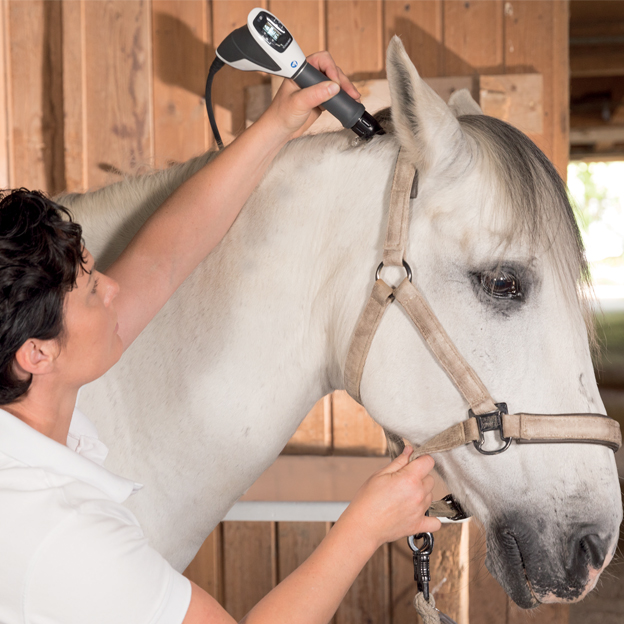Evaluating the Efficiency of Laser Treatment in Equine Therapy for Injury Recovery
The analysis of laser treatment's efficiency in equine injury rehab hinges on several elements, including recovery time, discomfort reduction, and cells regrowth. Veterinarians frequently observe superior outcomes with laser treatment contrasted to traditional methods, positioning it as an essential element in equine treatment.
Recognizing Laser Therapy
Laser therapy has actually come to be a crucial device in veterinary medicine, specifically in the therapy of equine conditions. Known for its non-invasive nature and efficiency, laser treatment includes the application of particular wavelengths of light to stimulate cells repair service and minimize inflammation. This healing technique is progressively preferred for its capability to accelerate the recovery procedure in equines dealing with a variety of musculoskeletal injuries and persistent conditions.
The main mechanism behind laser treatment is its ability to boost cellular functions. When laser light passes through the skin, it is absorbed by mitochondria, the giant of cells, which leads to boosted manufacturing of adenosine triphosphate (ATP) This biochemical energy increase promotes cellular repair work and regrowth. Additionally, laser therapy advertises vasodilation, improving blood flow and oxygen distribution to broken tissues, therefore expediting recovery.
In equine medicine, laser therapy is specifically advantageous for conditions such as tendonitis, osteoarthritis, and injury recovery. The strategy is lauded for its pain-relieving properties, enabling steeds to regain movement and function much more quickly. Vets additionally value its minimal negative effects compared to other therapy techniques, making it a reliable and safe choice for equine care.

Exactly How Laser Treatment Works

Upon absorption, these photons activate a series of biochemical changes, boosting mitochondrial feature and resulting in increased adenosine triphosphate (ATP) manufacturing. This increase in ATP accelerates mobile metabolic process, promoting tissue repair work and regeneration. In addition, laser therapy regulates inflammatory reactions by affecting cytokine degrees and reducing oxidative anxiety, thus relieving discomfort and swelling.
One more significant facet of laser treatment is its function in enhancing microcirculation. The treatment promotes vasodilation, enhancing blood circulation and oxygen shipment to broken tissues (Equine Therapy). This promotes the removal of mobile debris and supports the spreading of fibroblasts and collagen synthesis, important for injury healing
Scientific Evidence
The efficacy of laser therapy in equine therapy has actually been substantiated with different scientific researches, showcasing its healing potential across a range of conditions. A study carried out by Turner et al. (2012) showed that horses treated with low-level laser therapy (LLLT) for tendon injuries displayed accelerated healing compared to those receiving conventional treatments.
Likewise, research study by Johnson and associates (2015) concentrated on equine muscular tissue injuries, disclosing that laser treatment significantly sped up muscular tissue fiber regrowth and lowered muscle tightness. These findings were affirmed by histological evaluations revealing better muscle mass cells organization. Scientific analyses have shown that laser treatment can relieve persistent problems such as osteo arthritis. A research study by Smith et al. (2018) reported that equines with osteoarthritic joints experienced significant discomfort relief and increased series of movement complying with a program of laser therapy sessions.
Veterinarian Insights

Vets likewise appreciate the flexibility of laser therapy. It can be utilized for a vast range of problems, from surface injuries to deeper musculoskeletal injuries. Dr. Emily Brown highlights its utility in treating problems like tendonitis and osteoarthritis, where traditional treatments often fail. She mentions that laser treatment can be tailored to the certain requirements of each equine, ensuring ideal results.
Furthermore, vets value the capacity to incorporate laser treatment with various other therapy modalities. This multimodal approach can boost general treatment efficiency, supplying an extensive solution for equine recovery. Such endorsements from skilled experts underscore the expanding acceptance and application of laser treatment in equine medicine.
Practical Factors To Consider
An essential facet of carrying out laser therapy in equine treatment involves recognizing the useful factors to consider that ensure its efficiency and safety. It is vital to select the proper laser device, as different kinds differ in wavelength, power, and infiltration deepness. Veterinarians need to be well-versed in these specifications to customize treatment procedures properly to each injury kind
In addition, the frequency and duration of laser treatment sessions require careful preparation to optimize therapeutic benefits while decreasing any prospective damaging effects. Constant surveillance of the horse's reaction to therapy can lead necessary adjustments in the therapy program. Developing a secure and controlled environment throughout therapies is also vital to protect against unintentional exposure to laser discharges, which might damage both the steed and the trainer.
Training and accreditation of employees carrying out laser treatment are paramount to ensure proper technique and to support security requirements. Furthermore, keeping exact documents of each session, consisting of laser setups and observed end results, is essential for evaluating the overall effectiveness of the treatment and for making data-driven decisions.
Final Thought
Laser therapy has actually become a reliable click over here now method in equine injury recovery, supplying substantial benefits in recovery time, pain alleviation, and cells healing. Medical studies underscore significant renovations in problems such as tendonitis and osteo arthritis, associated to enhanced mobile feature and have a peek at this site boosted ATP manufacturing. Veterinarian observations corroborate these findings, highlighting superior end results contrasted to standard therapies. For optimal results, continual tracking and personalized therapy methods stay vital in leveraging the full possibility of laser therapy in equine treatment.
Comments on “The Power of Equine Therapy for Anxiety, PTSD, and Emotional Healing”